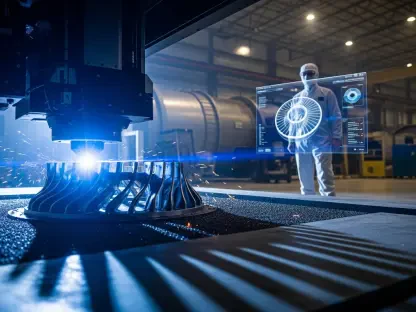Natilus, a Californian aerospace manufacturer, has recently unveiled its pioneering passenger aircraft, ‘Horizon’. This aircraft is making significant headlines due to its cutting-edge blended-wing-body (BWB) design, which promises to revolutionize the aviation industry through enhanced sustainability, efficiency, and profitability. Aleksey Matyushev, the CEO and co-founder of Natilus, believes that the ‘Horizon’ is a monumental advancement, specifically aimed at helping commercial aviation meet its ambitious net-zero targets by 2050. With the aerospace industry facing growing scrutiny over its environmental impact, the ‘Horizon’ comes as a promising solution to these substantial challenges.
Innovative Design and Benefits of the ‘Horizon’
The ‘Horizon’ aircraft stands out for its advanced BWB design, a significant departure from conventional tube-and-wing configurations. This innovative design brings several noteworthy benefits that could change the face of air travel. Firstly, the aerodynamic efficiency is greatly improved with the BWB structure, leading to reduced fuel consumption. With the aviation industry under immense pressure to minimize its carbon footprint, this feature could be crucial. Secondly, the interior volume of the ‘Horizon’ is up to 40% greater than traditional aircraft, offering the flexibility for customizable cabin and seating layouts, thereby enhancing passenger comfort and maximizing capacity.
Moreover, the ‘Horizon’ consumes 30% less fuel compared to conventional passenger aircraft, significantly impacting both operational costs and environmental sustainability. The quieter operation enabled by the BWB design is also beneficial, particularly for densely populated areas around major airports, where noise pollution can be a critical issue. This combination of features not only redefines operational efficiency but also aligns with global environmental goals, making ‘Horizon’ a game-changer in various aspects.
Market Demand and Industry Trends
The aviation industry is currently experiencing a surge in demand for both passenger and freight aircraft, with projections suggesting that this demand will outstrip manufacturing capabilities over the next two decades. This heightened demand, coupled with increasing environmental concerns, underscores the pressing need for more efficient and lower-emission aircraft. The ‘Horizon’ fits neatly into these trends, offering a viable solution to the industry’s growing demands.
As airlines and manufacturers worldwide work towards achieving net-zero emissions by 2050, the ‘Horizon’ by Natilus promises to play a pivotal role in the future landscape of commercial aviation. The aircraft’s design and operational efficiencies make it well-aligned with the current and future needs of an industry in transition. The potential of ‘Horizon’ to meet stringent environmental regulations and deliver economic benefits places it at the forefront of aviation innovation.
Compatibility and Future Forecast
Designed to fit into the same payload class as industry staples like the Boeing 737 and Airbus 320, the ‘Horizon’ aircraft promises seamless integration into existing airline operations. This optimized compatibility is expected to minimize operational disruptions and enhance overall efficiency for airlines worldwide. Customer deliveries for the ‘Horizon’ are anticipated to begin in the early 2030s, aligning perfectly with the fleet purchasing timelines of commercial carriers focused on environmental sustainability.
The ‘Horizon’ is also engineered to be compatible with existing gate operations and airport infrastructure, further ensuring a smooth adoption process for airlines. The ability to integrate this revolutionary technology without significant changes to current systems is crucial for its success and widespread adoption. Airlines will find it easier to transition to more sustainable operations, thereby fostering a broader industry shift towards greener aviation practices.
Comparative Advantage and Industry Impact
Dennis Muilenburg, Chairman and CEO of New Vista Capital and former CEO of Boeing, highlights the transformative potential of the ‘Horizon’. He asserts that this aircraft has the capacity to revolutionize fleet operations by maximizing capacity and providing an elevated passenger experience. In a highly competitive and environmentally-conscious market, these attributes are not just beneficial but essential for long-term success.
The operational efficiency and cost savings promised by the ‘Horizon’ stand out as significant advantages. As airlines continually seek ways to enhance their economic and environmental performance, the ‘Horizon’ offers a tangible pathway to achieving these goals. Such advancements could prompt significant industry shifts, encouraging more airlines to adopt sustainable practices and integrate advanced technologies into their fleets, thereby accelerating the push towards greener aviation.
Previous Success: Kona Cargo Aircraft
Natilus has already demonstrated the efficacy of its BWB technology through the successful development of the Kona cargo aircraft. Set for its first customer delivery in the late 2020s, the Kona cargo aircraft has laid the foundational groundwork for the ‘Horizon’. The insights and technological advancements garnered from the Kona project have been instrumental in shaping the design and functionality of the ‘Horizon’.
This proven track record boosts confidence in Natilus’s ability to deliver on its promises for the passenger aircraft market. The success of the Kona aircraft underscores the company’s expertise in BWB technology, supporting the anticipated success and effectiveness of the ‘Horizon’. Such prior achievements only enhance the credibility of Natilus’s ambitious undertaking with the ‘Horizon’ and its potential to reshape the aviation landscape.
Broader Industry Context
The introduction of the ‘Horizon’ is part of a larger movement within the aviation industry aimed at modernization and enhanced sustainability. As the industry faces emerging threats, innovative security and operational solutions have become paramount. Current reports emphasize the critical importance of cybersecurity, passenger data protection, and maintaining efficient operations to ensure smooth and secure travel experiences.
In this broader context, the ‘Horizon’ aligns with ongoing efforts to integrate cutting-edge technology and robust security measures into aviation practices. The aircraft’s advanced design complements broader industry initiatives, making it a strategically significant addition to the fleets of future-forward airlines. The ability of ‘Horizon’ to meet these multifaceted demands underscores its role in the next generation of aviation solutions.
Industry Reactions and Leadership Insights
Several industry leaders and stakeholders have voiced their support for adopting new technologies and sustainable practices, emphasizing the critical intersections of innovation and environmental responsibility. Figures from major hubs like Aeroporti Di Roma, Copenhagen Airport, and Los Angeles World Airports recognize the substantial benefits that the ‘Horizon’ could bring to the industry.
These advocates stress the importance of addressing emerging security challenges with cutting-edge technologies, implementing robust data protection systems, and streamlining operational processes. By championing these aspects, these leaders are at the forefront of promoting efficient and secure practices in the aviation industry. Their collective endorsement signals strong industry support for the adoption of advanced and sustainable aircraft like the ‘Horizon’.
Platforms for Industry Engagement
Natilus, a forward-thinking aerospace manufacturer based in California, has recently introduced its innovative passenger aircraft named ‘Horizon’. This aircraft has garnered significant attention for its groundbreaking blended-wing-body (BWB) design. The BWB design is poised to bring about a major shift in the aviation industry by offering improvements in sustainability, efficiency, and profit margins. Aleksey Matyushev, the CEO and co-founder of Natilus, regards the ‘Horizon’ as a monumental leap forward, aimed at assisting commercial aviation in achieving its ambitious net-zero emissions goals by the year 2050. As the aerospace sector faces increasing scrutiny over its environmental footprint, the ‘Horizon’ emerges as a beacon of hope, presenting a viable solution to these pressing environmental challenges. Given the rising concern over climate change and the imperative to reduce carbon emissions, the introduction of the ‘Horizon’ comes at a critical time. The aircraft’s design promises not only to lessen the environmental impact of air travel but also to set a new standard for future aviation innovation, paving the way for a more sustainable future.









